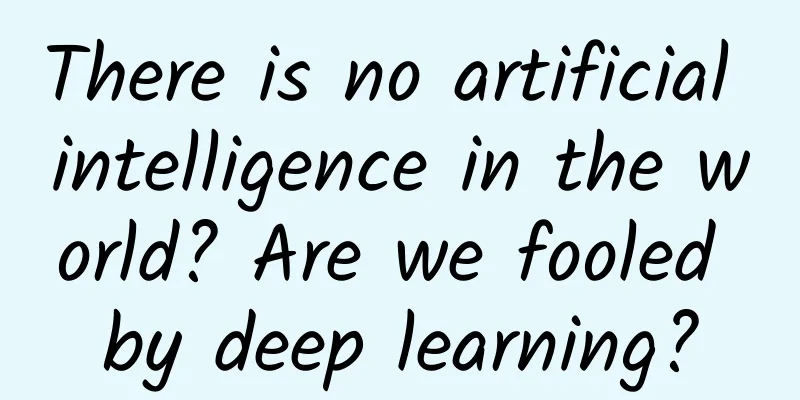There is no artificial intelligence in the world? Are we fooled by deep learning?

|
The author, Jean-Christophe Baillie, founder and president of Novaquark, said, "There is no artificial intelligence without robots." In this article, he discusses what artificial intelligence is and why AlphaGo cannot be called artificial intelligence. What is artificial intelligence and what is not?There is no doubt that AlphaGo, the "artificial intelligence Go system" designed by Google DeepMind, is a very smart system. AlphaGo defeated the Go world champion Lee Sedol, and similar deep learning methods have been used to solve complex computing problems in various industries. Thanks to AlphaGo, the term artificial intelligence has once again become the focus of people's attention. However, the author of this article does not think that AlphaGo belongs to artificial intelligence because it does not involve general artificial intelligence (AGI). To build general artificial intelligence, one of the key issues is to let it avoid being restricted by the designer and let it exert its own energy. It can develop intrinsic meaning from what it encounters, hears, says, does and experiences, just like humans. On the contrary, today's artificial intelligence programs are basically unable to understand what is happening around them, nor can they handle problems in other fields. So what is artificial intelligence? This may be the most fundamental question about artificial intelligence.
In 1990, cognitive scientist Stevan Harnad explored the problem of meaning in his paper "The Symbol Grounding Problem". Any representative symbol exists in the external real world. For example, suppose you have to learn Chinese as a second language, and the only source of information you have is a Chinese dictionary. The process of learning through a dictionary is like riding an endless merry-go-round, constantly exposed to one meaningless symbol after another. So how do you get out of this vicious circle? How can a symbol have meaning? This is a typical symbol grounding problem. The question of the meaning of artificial intelligence was raised decades ago, but there is still no solution to this problem. This problem can be broken down into four sub-problems. 1. How to construct the information received by humans or artificial intelligence from the outside?This is the first question about the meaning of artificial intelligence, about structuring information. With the rapid development of machine learning, especially deep learning and unsupervised learning, this problem has been well solved in recent years. The great progress, including AlphaGo, is partly due to the progress of graphics processor technology, which is very good at processing information. These effective algorithms, such as deep learning algorithms, use the most useful information in a high-dimensional space to read complex data. For today's artificial intelligence, supervised learning is undoubtedly the most successful application. For example, three algorithms, Naive Bayes Classification, Logistic Regression, and Support Vector Machine, can generate billions of dollars in value each year. But the unsupervised learning mentioned above is also developing rapidly. Clustering algorithms and principal component analysis solve many problems that supervised learning cannot solve. In addition, semi-supervised learning and reinforcement learning are also increasingly widely used in enterprises. Although there are many useful and powerful algorithms to solve different AI problems, there is no general AI system that can handle all situations, and no one knows which of the many AI systems can be used to build general AI. In my opinion, deep neural networks with unsupervised learning will provide the greatest help in realizing this dream. For example, IBM's Watson integrates many algorithms in order to process a wide variety of data. However, many researchers believe that it is impossible to build general artificial intelligence without the help of cognitive psychology and neuroscience. There is still a long way to go to make this dream come true. 2. How to connect this structured information with the outside world, or as mentioned above, to create meaning?After structuring the information, the second problem is to connect the structured information to the real world, which gives the fundamental meaning to robotics. The premise of being able to interact with the outside world is to have a body, so there is no artificial intelligence without robotics. This realization is often called the "embodiment problem". Most artificial intelligence researchers now believe that embodiment is as important as intelligence for artificial intelligence. Looking at the real world, especially the animal world, we can find that each different body has different forms of intelligence. This avatar problem starts with understanding the body parts, then controlling them and producing desired effects in the observed world, ultimately building up its own understanding of the world. This process is called "sensorimotor theory" and has been studied by J. Kevin O'Regan and others. 3. How to synchronize this meaning with other artificial intelligence media?The question is about the origin of culture. Unlike humans, some animals express their culture through things like dance and smell. Without culture, the fundamental catalyst of intelligence, artificial intelligence would be little more than an academic endeavor. However, culture is a learning process that encompasses psychology and cognitive abilities. It is not something that can be hand-coded into a machine. By studying how children acquire culture, researchers are trying to understand this learning process. This process is also closely linked to language learning, which is a gradual process: the AI medium interacts with the world, acquires new information from it, creates new meaning, and then creates new meaning by communicating with other media, and chooses the most successful way to communicate. After hundreds or thousands of mistakes, researchers can build the largest AI system. This is something that deep learning cannot explain. Some research labs, such as SoftBank Robotics, are using this process to gain more information about complex cultural traditions. 4. Why does the AI medium need to do anything? How to turn all this into action?***This question is about expectations. AI agents will act because of intrinsic motivations, for example, human behavior is not just to meet the needs of survival, but to further explore, which is driven by intrinsic curiosity. Scholars like Pierre-Yves Oudeyer believe that simple mathematical formulas are enough to explain complex behaviors. Limitations of existing AI systemsAs far as the author understands, there is no artificial intelligence in the world today, not even the most commonly used and popular artificial intelligence services and applications. Although his view is not universal, the current AI systems do have limitations. Siri is Apple's latest AI system, but it cannot recognize what you say if it is beyond its task scope. SoftBank's latest AI robot Pepper has the same limitations as Siri. In addition, although it is equipped with a voice recognition system, it sometimes fails to recognize the true emotions behind the voice and is easily deceived. E-commerce giant Alibaba Group and its online payment service provider Alipay are working on using facial recognition technology to replace passwords. Its accuracy is good, but it still cannot recognize twins with similar faces. These examples reflect that current artificial intelligence is not smart enough. Sometimes it can't even process the data it gets from the outside world, let alone interact. In conclusion, we are happy to see the rapid development of deep learning and the great success of AlphaGo, because they can be widely used in medical research, environmental protection and many other fields. However, deep learning is not a good way for humans to master true artificial intelligence technology. True artificial intelligence can learn from the outside world, interact with humans naturally, understand human emotions, intentions and cultural differences, and ultimately help us create a better world. |
>>: Transfer Learning: How to Learn Deeply When Data Is Insufficient
Recommend
Summary of Xiaohongshu’s operation and promotion methods!
Traffic exposure 1. The traffic for the note I po...
The Gate of True Love "Matrix Awakening" video tutorial
The Gate of True Love "Matrix Awakening"...
Xiaohongshu product analysis report!
Xiaohongshu has accumulated a user word-of-mouth ...
What should I do if I encounter negative reviews in the Apple App Store? Use these 6 methods to help you solve the problem!
Those who do operations are afraid of encounterin...
Spring Festival red envelope war: the biggest loser is the bank
[[128082]] There is no doubt that Alibaba and...
How to simplify the 400 phone application
How to simplify the application for 400 telephone...
The secret code of Weibo "stalk" marketing traffic
Farewell and longing for the distant past, breaki...
Ten secrets that new programmers should know
You are a freshman who steps into the workplace w...
My first experience with advertising embedded in the body of a public account. What is the promotion effect?
Some time ago, my official account was fortunate ...
Basic concepts in APP promotion: CPA, CPC, CPD
Let me first introduce to you: the basic concepts...
Why do people shiver when it’s cold?
When I was a child, I heard a fable about the Cuc...
Mobile games are rushing to gain market share during the summer vacation. Missing out on these channels means missing out on millions of users!
It's summer vacation again, and this year'...
APP user growth data logic!
APP growth is inseparable from the application of...
Apple rolls out iOS 14.5 with controversial privacy features
Apple officially released the update for all iPho...









